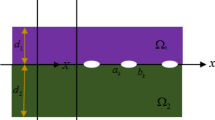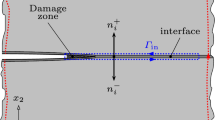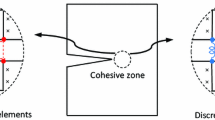Abstract
The initiation of coplanar, interfacial cracks is considered with a view to examining mixed-mode fracture parameters and criteria. The point-loaded blister configuration provided a simple axisymmetric geometry and table crack growth between glass and an epoxy. Crack opening displacements normal to the interface were measured with submicron resolution using crack opening interferometry. The measurements were made within 2.7 μm from the crack front over a field of view of 500 μm, thus allowing the extent of inelastic behavior to be evaluated. A complementary finite element analysis was used to determine tangential crack opening displacements and other linear elastic mixed-mode fracture parameters, all of which were found to increase with relative increases in mode II component. The results were attributed to related increases in the extent of material nonlinear behavior in the crack front region. The normal crack opening displacement fields in the plastic zone exhibited a power law dependence on radial distance from the crack front. Critical values of normal crack opening displacements evaluated at a distance of 12.7 μm from the crack front were not constant under the range of mixed-mode conditions examined, indicating that any fracture criterion is likely to be a function of the mode-mix for the particular material combination considered here.
Résumé
On considère l'amorçage de fissures coplanaires et d'interfaces en vue d'un examen des critères et des paramétres de rupture selon un mode mixte. La configuration en cupules soumises à charge ponctuelle fournit une géométrie axysymétrique simple et des conditions de croissance stable d'une fissure entre du verre et un epoxy. En utilisant une technique d'interférométrie à l'endroit d'ouverture de la fissure, on mesure les COD selon la normale a l'interface avec une résolution submicronique. Les mesures ont été effectuées sur 12,7 microns depuis le front de la fissure, sur un champ d'expérience de quelque 500 microns, ce qui permet d'évaluer l'étendue du comportement inélastique. On utilise une analyse complémentaire par éléments finis pour déterminer les COD tangentiels, ainsi que d'autres paramètres de rupture selon une mode linéaire élastique mixte; tous ces paramètres sont identifiés comme croissant avec une augmentation relative de la composante de mode II. Les résultats sont appliqués aux accroissements associés constatés dans l'étendue du comportement non linéaire du matériau dans la zone du front de fissure. Les champs normaux de COD dans la zone plastique suivent une loi parabolique en fonction de la distance qui les sépare radialement du front de fissure. Les valeurs critiques du COD selon la normale, évalués à une distance de 12,7 microns à partir du front de fissure ne sont pas constantes sur une certaine gamme de conditions en mode mixte examinées, ce qui indique que tout critère de rupture est sans doute fonction de la combinaison des modes, pour la combinaison particulière de matériaux envisagée dans le présent travail.
Similar content being viewed by others
References
W.S. Johnson and P.D. Mangalgiri, “Influence of the Resin on Interlaminar Mixed-Mode Fracture,” NASA TM 87571 (1985) to appear in Toughened Composites, ASTM STP XXX (1987).
M.L. Williams, Bulletin of the Seismological Society of America 49 (1959) 199–204.
H. Dannenberg, Journal of Applied Polymer Science 5 (1961) 125–134.
A. Piva and E. Viola, Engineering Fracture Mechanics 13 (1980) 143–174.
K.M. Liechti, Experimental Mechanics 25 (1985) 255–261.
J.F. Yau and S.S. Wang, Engineering Fracture Mechanics 20 (1984) 423–432.
S.S. Wang and J.F. Yau, International Journal of Fracture 19 (1982) 295–309.
G.B. Sinclair, International Journal of Fracture 16 (1980) 111–119.
C. Atkinson, International Journal of Fracture 19 (1982) 131–138.
T.N. Farris and L.M. Keer, International Journal of Fracture 27 (1985) 91–103.
E. Wu and R.L. Thomas, Proceedings 5th International Congress of Rheology University Park Press, Baltimore, 1 (1969) 575–587.
T.T. Wang, T.K. Kwei and H.M. Zupko, International Journal of Fracture Mechanics 6 (1970) 127–137.
G.P. Anderson, K.L. DeVries and M.L. Williams, International Journal of Fracture 10 (1974) 565–583.
G.P. Anderson, K.L. DeVries and M.L. Williams, Journal of Colloid and Interface Science 47 (1974) 600–609.
N. Takashi, K. Yamazaki, T. Natsume and T. Takebe in 21st Japan Congress on Materials Research-Non-Metallic Metallic Materials (1978) 260–264.
M. Yamazaki and M. Takashi, in 21st Japan Congress on Materials Research-Non-Metallic Materials (1973) 255–259.
D.R. Mulville, P.W. Mast and R.N. Vaishnav, Engineering Fracture Mechanics (1976) 555–565.
D.R. Mulville and R.N. Vaishnav, Adhesion 7 (1975) 215–233.
D.R. Mulville, D.L. Hunston and P.W. Mast, Journal of Engineering Materials and Technology 100 (1978) 25–31.
E. Sommer, Engineering Fracture Mechanics 1 (1970) 705–718.
K.M. Liechti and W.G. Knauss, Experimental Mechanics 22 (1982) 262–269.
K.M. Liechti and W.G. Knauss, Experimental Mechanics 22 (1982) 383–391.
K.M. Liechti, D. Ginsburg and E.C. Hanson, Journal of Adhesion 23 (1987) 123–146.
K. Arin and F. Erdogan, International Journal of Engineering Science 9 (1971) 213–232.
R.E. Smelser, International Journal of Fracture 15 (1979) 135–143.
J.D. Achenbach, L.M. Keer, R.P. Kheetan and S.H. Chen, Journal of Elasticity 9 (1979) 397–424.
J.W. Hutchinson, Journal of the Mechanics and Physics of Solids 16 (1968) 13–31.
J.R. Rice and G.F. Rosengren, Journal of the Mechanics and Physics of Solids 16 (1968) 1–12.
Author information
Authors and Affiliations
Rights and permissions
About this article
Cite this article
Liechti, K.M., Hanson, E.C. Nonlinear effects in mixed-mode interfacial delaminations. Int J Fract 36, 199–217 (1988). https://doi.org/10.1007/BF00035100
Received:
Accepted:
Issue Date:
DOI: https://doi.org/10.1007/BF00035100




